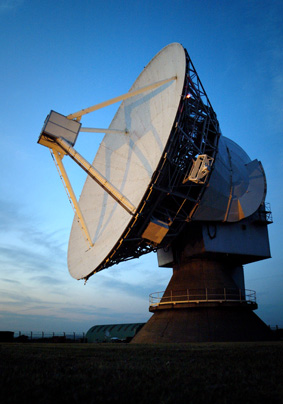Chilbolton
The Chilbolton Facility for Atmospheric and Radio Research
 Our group has close links with the Chilbolton Observatory in Hampshire, which offers a unique suite of active and passive instruments for measuring clouds, aerosols and precipitation. It is home to the world’s largest steerable meteorological radar, whose 25m antenna provides an angular resolution four times higher than typical weather radars.
Our group has close links with the Chilbolton Observatory in Hampshire, which offers a unique suite of active and passive instruments for measuring clouds, aerosols and precipitation. It is home to the world’s largest steerable meteorological radar, whose 25m antenna provides an angular resolution four times higher than typical weather radars.
Many instruments are operated 24/7 providing continuous data sets of cloud and aerosol properties, which allow long-term statistics to be analysed, and are particularly valuable for model evaluation. These data feed into the CloudNet and ACTRIS european networks.
Data collected by the Chilbolton instruments is freely available via the British Atmospheric Data Centre, or by contacting the head of the facility.
CAMRA RADAR
- The Chilbolton Advanced Meteorological Radar is installed on the 25m antenna, and has an extremely narrow beam (0.28 degrees 1-way FWHM), allowing very high resolution measurements. The transmitter is a powerful magnetron system, which transmits 500kW pulses. The raw range resolution is 75m. The radar has full dual-polarisation and Doppler capability.
- A second fully coherent transmitter system is currently being developed. This TWTA system will allow the use of very long pulses and pulse compression techniques
OTHER RADARS
- The 35 GHz Copernicus radar operates 24/7 producing profiles of clouds every 30 s. As well as standard reflectivity and Doppler parameters, it records Doppler spectra samples once per minute. The radar has full dual-polarisation capability.
- The 94 GHz Galileo radar operates on an “on-demand” basis. Profiles of clouds are recorded once per second, as well as Doppler spectra profiles once per minute. The radar has recently been upgraded to dual-polarisation, and allows for arbitrary spacing of H and V pulses.
- The METEK 35 GHz scanning cloud radar is part of the NCAS Atmospheric Measurement Facility. It is based at Chilbolton, but is mounted on a trailer, and can be deployed on field campaigns. It has a powerful magnetron transmitter which makes it sensitive to weak cloud echoes without the need for pulse compression techniques, and can scan rapidly to build up a 3D view of a cloud field.
- The NCAS X-band mobile radar is also part of the Atmospheric Measurement Facility, and will be based at Chilbolton when not being used on field campaigns
LIDARS
- Vaisla CL51 lidar ceilometer. This lidar operates 24/7 and provides profiles of clouds and aerosols every 30 s
- HALO Doppler Lidar. Doppler capability allows vertical velocity measurements, and retrieval of wind profiles.
- A powerful UV Raman lidar is available on-demand. The Raman channel allows retrieval of water vapour profiles.
PASSIVE INSTRUMENTS
- Radiometrics Microwave radiometer. Uses a range of channels between 22-28 GHz to retrieve water vapour and liquid water paths, and performs scans to derive profiles.
- Cimel Sunphotometer. Retrieves aerosol optical depth during clear sky, and cloud optical depth during overcast conditions (retrievals are available through the AERONET website).
GAUGES, DISDROMETERS AND METEOROLOGICAL SENSORS
- Fast-response drop-counting rain gauges. These gauges, built in-house, can measure rainfall in increments as small as 0.0019mm, allowing over 100x higher resolution rainfall than standard tipping-bucket gauges (which sample in 0.2 mm increments)
- Joss-Waldvogel RD-80 disdrometers. There is one instrument at Chilbolton itself, and another 7 km away at Sparsholt college.
- There are numerous other meteorological sensors at Chilbolton for precipitation, temperature, humidity, heat fluxes, and other parameters. More information is available here
LINKS
- Chilbolton has its own set of webpages here
- This pathe news film documents the opening of Chilbolton in 1967
